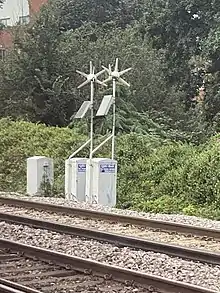Rail squeal
Rail squeal is a screeching train-track friction sound, commonly occurring on sharp curves.
Squeal is presumably caused by the lateral sticking and slipping of the wheels across top of the railroad track. This results in vibrations in the wheel that increase until a stable amplitude is reached.[1]

Lubricating the rails has limited success. Speed reduction also appears to reduce noise levels.[2]
The sticking of the rim of the wheel causes the wheel to ring like a bell, so rubber dampers or tuned absorbers are a possible solution to lower the volume. The MBTA Green Line, for example, suffers from severe rail squeal on the sharp curves within the central subway. Flange stick graphite lubricators have been installed on trains to attempt to mitigate the rail squeal issue.[3]
The mechanism that causes the squealing also is the cause of wear and tear that is happening in the wheel–rail interface.
Factors
Factors include:[4]
- Accelerating, coasting or braking
- Diameter of wheel
- Powered or unpowered wheels
- Radius of curve
- Rail lubrication
- Slant of rail (typically 1 in 20)
- Superelevation or cant
- Type of train
- Weather (rails wet or dry) (slippery rail)
- Wheelbase
- Worn profile of wheel
- Worn profile of rail
See also
References
- Rudd, M.J. (1976). "Wheel/rail noise—Part II: Wheel squeal". Journal of Sound and Vibration. 46 (3): 381–394. Bibcode:1976JSV....46..381R. doi:10.1016/0022-460X(76)90862-2.
- Barnt Green Rail Noise - summary by Les Bailey
- Why the MBTA's Wheels Squeal -- And How It's Trying to Dampen the Noise
- Thompson, D.J.; Squicciarini, G.; Ding, B.; Baeza, L. (2018). "A State-of-the-Art Review of Curve Squeal Noise: Phenomena, Mechanisms, Modelling and Mitigation". Noise and Vibration Mitigation for Rail Transportation Systems. Notes on Numerical Fluid Mechanics and Multidisciplinary Design. Vol. 139. pp. 3–41. doi:10.1007/978-3-319-73411-8_1. hdl:10251/137594. ISBN 978-3-319-73410-1. S2CID 125601090.